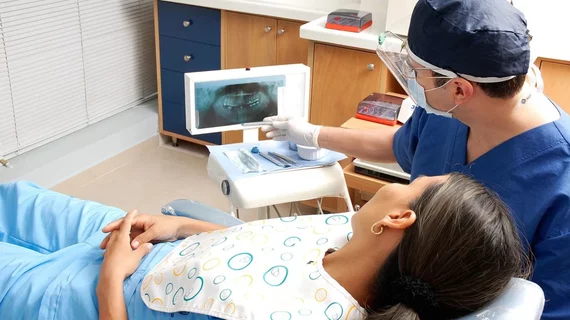3 pointers to avoid transmitting COVID-19 in emergency oral radiology
As dental and oral-surgery offices begin to reopen in the U.S. on a state-by-state basis—some allowing all services, others only urgent care at first—oral-radiology experts in hard-hit Iran are offering tips from their experience with COVID-19.
While the authors’ primary focus is protecting patients and staff in emergency oral radiology, the principles behind the recommendations apply to routine practice as well.
Academic Radiology published the team’s brief as a letter to the editor May 7.
“Individuals with COVID-19 may be asymptomatic or pre-symptomatic (20% to 86% of all infections),” radiologist Pooya Iranpour, MD, of Shiraz University and colleagues point out. “Thus, it is common that asymptomatic patients with undiagnosed COVID-19 present emergently to dental clinics.”
Stating that their recommendations presume normal preventative protocols—hand hygiene, disinfection of surfaces, personal protective measures—Iranpour and co-authors cover three issues deserving of special consideration:
- Ask the patient not to wear a face mask during oral radiography, whether the exam is for intraoral or extraoral imaging. “It is of utmost importance that the distance from an x-ray room to the dental operatory (treatment room) should follow a standard guideline to prevent aerosol transmission,” the authors write, citing evidence that dental aerosol can reach up to 10 feet from its source and then linger awhile in the air.
- Use teleradiology if at all possible. Handled films or hard copies of images can easily transmit COVID-19. That’s largely because disinfectants could compromise image quality, reducing the available diagnostic information, the authors remind.
- When feasible, opt for extra-oral radiographs over intraoral images. A high-quality digital panoramic view may do the job in an emergency setting, the authors suggest. Meanwhile, in cases of dental trauma, small field of view cone beam CT is probably best.
When procedural periapical radiographs are unavoidable, the authors note, it’s imperative to use an antimicrobial oral rinse pre-procedure. “Mouth rinse containing oxidative agents such as 0.2% povidone or 1% hydrogen peroxide is recommended due to the vulnerability of COVID-19 to oxidation,” they add. “Measures to prevent gag reflex are advised, as activation of the gag reflex may elicit coughing and coronavirus spread. A preventive approach can be psychological, pharmacological or even technical.”
Iranpour and colleagues conclude: “Many aspects of oral and maxillofacial radiology, including the type of the image, taking the radiograph and transferring the diagnostic information to the clinician, should be strictly revised to further reduce the chance of COVID-19 transmission.”

